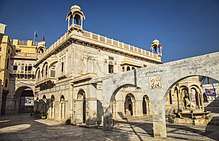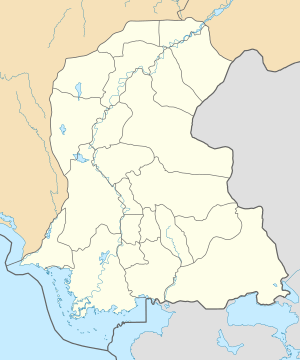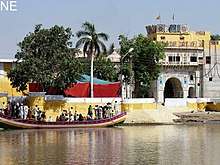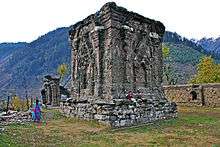Sadh Belo
| Sadh Belo سادھ بھيلو | |
|---|---|
 | |
 Location within Sindh  Sadh Belo (Pakistan) | |
| Geography | |
| Coordinates | 27°41′38″N 68°52′43″E / 27.69389°N 68.87861°ECoordinates: 27°41′38″N 68°52′43″E / 27.69389°N 68.87861°E |
| Country |
Pakistan |
| State | Sindh |
| District | Umerkot Division |
| Culture | |
| Major festivals | Shiv Ratri |
| Architecture | |
| Architecture | Hindu temple |
| Number of temples | 1 |
| History | |
| Governing body | Pakistan Hindu Council |
| Website | http://www.pakistanhinducouncil.org/ |
Sadh Belo (Urdu: سادھ بھيلو,Sindhi: ساڌ ٻيلو), or Sat, is an island in the Indus River near Sukkur, Sindh, Pakistan that is famous for its highly revered Hindu temples.[1] The temples are associated with the syncretic Udasi movement,[2] which had close associations with Sikhism until an early 20th century reform movement expelled Udasis from numerous Sikh shrines.
Etymology

During the Arab conquest of Sindh under Muhammad bin Qasim, the island was occupied by an Arab commander named "Saeed" (Arabic: سعید). His platoon eventually was stationed on the island, and the island was named as Sadh Belo, or "Saeed's Island" in his honour.[3]
Geography
Sadh Belo island is downstream from Bukkur island, and is separated from it by a short stretch of river. The island with its two inlets, Sadh Belo and Din Belo, is shown on the official map of 1893-4; in 1912 it was accurately surveyed on the orders of the Collector.
Demography
Sindhi are settled in Sadh Belo and the surrounding countryside. The majority of the population is Muslim with a significant Hindu minority.
Hindu temple
There is a Hindu temple on the island, founded in 1823 by Baba Bankhandi Maharaj, who had immigrated from Nepal.[4] The place is held in high esteem by Hindus throughout Sindh and even in India, occasionally attracting pilgrims from across the border.[5] The annual death anniversary of Baba Bankhandi Maharaj, analogous to the Sufi urs, is celebrated by a three-day festival in which pilgrims are provided with free lodging, food, and water.[6] It is under the custody of Evacuee Property Trust Board.[7]
Gallery
 Devotees reach the Sadh Belo temple, which is situated in the middle of the Indus River.
Devotees reach the Sadh Belo temple, which is situated in the middle of the Indus River. The temple complex at night
The temple complex at night
See also
References
- ↑ Kothari, Rita (2007). The burden of refuge: the Sindhi Hindus of Gujarat. Orient Longman. ISBN 9788125031574.
- ↑ Thakur, U. T. (1959). Sindhi Culture. University of Bombay.
|access-date=requires|url=(help) - ↑ Razzak, Abdul (1965). Souvenir of Sukkur. Sukkur (Pakistan). Municipal Committee. Retrieved 12 September 2017.
- ↑ Balach, Dharmindar (11 June 2017). "NO INDIAN HINDU CAME FOR SHADU BELLA TEMPLE FESTIVAL". Retrieved 12 September 2017.
- ↑ "SUKKUR: Indian pilgrims worship at Sadh Belo, Arore Temple". www.dawn.com. 2006-12-07. Retrieved 2015-12-27.
- ↑ "Hindus pay homage at Sadh Belo temple". Express Tribune. 21 June 2016. Retrieved 12 September 2017.
- ↑ https://www.dawn.com/news/1413676/sadh-belo-temple-an-abode-of-udasipanth-in-sindh
